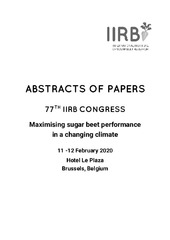Prikaz osnovnih podataka o dokumentu
Influence of NPK mineral nutrition and cultivar on sugar beet root rot
| dc.creator | Stojšin, Vera | |
| dc.creator | Budakov, Dragana | |
| dc.creator | Ćurčić, Živko | |
| dc.creator | Stankov, Aleksandra | |
| dc.creator | Dudaš, Tatjana | |
| dc.creator | Bagi, Ferenc | |
| dc.creator | Nagl, Nevena | |
| dc.date.accessioned | 2024-02-08T10:04:46Z | |
| dc.date.available | 2024-02-08T10:04:46Z | |
| dc.date.issued | 2020 | |
| dc.identifier.uri | http://fiver.ifvcns.rs/handle/123456789/4250 | |
| dc.description.abstract | Sugar beet is susceptible to a number of root rot diseases, and they are regularly occurring in Serbia. Economically most important pathogens are Macrophomina phaseolina and Fusarium spp.. Macrophomina phaseolina is predominantly found in isolates from sugar beet, especially during dry and hot summers. For more than thirty years already, our team of researchers follows the occurrence and etiology of sugar beet root rot in Serbia. The aim of this experiment was to evaluate the effect of mineral nutrition on root rot in commercial sugar beet cultivars. | sr |
| dc.language.iso | en | sr |
| dc.publisher | International Institute of Sugar Beet Research | sr |
| dc.rights | openAccess | sr |
| dc.rights.uri | https://creativecommons.org/licenses/by/4.0/ | |
| dc.source | Abstracts of Papers, 77th International Institute of Sugar Beet Research (IIRB) Congress "Maximising sugar beet performance in a changing climate", 11-12 February 2020, Brussels | sr |
| dc.subject | NPK fertilizers | sr |
| dc.subject | mineral nutrition | sr |
| dc.subject | cultivars | sr |
| dc.subject | sugar beet | sr |
| dc.subject | root rot | sr |
| dc.subject | pathogens | sr |
| dc.title | Influence of NPK mineral nutrition and cultivar on sugar beet root rot | sr |
| dc.type | conferenceObject | sr |
| dc.rights.license | BY | sr |
| dc.citation.epage | 70 | |
| dc.citation.spage | 70 | |
| dc.identifier.fulltext | http://fiver.ifvcns.rs/bitstream/id/11421/bitstream_11421.pdf | |
| dc.identifier.rcub | https://hdl.handle.net/21.15107/rcub_fiver_4250 | |
| dc.type.version | publishedVersion | sr |


